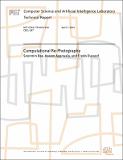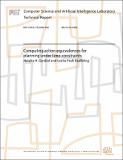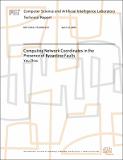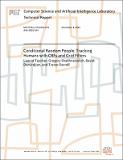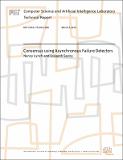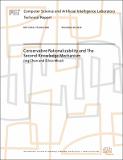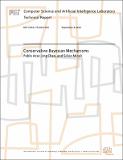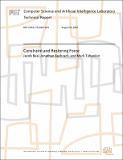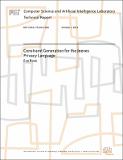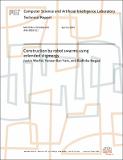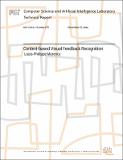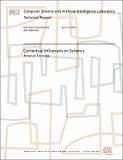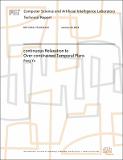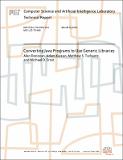Browsing CSAIL Digital Archive by Title
Now showing items 169-188 of 806
-
The computational magic of the ventral stream: sketch of a theory (and why some deep architectures work).
(2012-12-29)This paper explores the theoretical consequences of a simple assumption: the computational goal of the feedforward path in the ventral stream -- from V1, V2, V4 and to IT -- is to discount image transformations, after ... -
Computational Re-Photography
(2010-04-07)Rephotographers aim to recapture an existing photograph from the same viewpoint. A historical photograph paired with a well-aligned modern rephotograph can serve as a remarkable visualization of the passage of time. However, ... -
Computing action equivalences for planning under time-constraints
(2006-03-20)In order for autonomous artificial decision-makers to solverealistic tasks, they need to deal with the dual problems of searching throughlarge state and action spaces under time pressure.We study the problem of planning ... -
Computing Network Coordinates in the Presence of Byzantine Faults
(2009-04-16)Network coordinate systems allow for efficient construction of large-scale distributed systems on the Internet. Coordinates provide locality information in a compact way, without requiring each node to contact every potential ... -
Conceptual Design of Software: A Research Agenda
(2013-08-08)A research agenda in software design is outlined, focusing on the role of concepts. The notions of concepts as "abstract affordances" and of conceptual integrity are discussed, and a series of small examples of conceptual ... -
Conditional Random People: Tracking Humans with CRFs and Grid Filters
(2005-12-01)We describe a state-space tracking approach based on a Conditional Random Field(CRF) model, where the observation potentials are \emph{learned} from data. Wefind functions that embed both state and observation into a space ... -
Consensus using Asynchronous Failure Detectors
(2015-03-02)The FLP result shows that crash-tolerant consensus is impossible to solve in asynchronous systems, and several solutions have been proposed for crash-tolerant consensus under alternative (stronger) models. One popular ... -
Conservative Rationalizability and The Second-Knowledge Mechanism
(2010-12-20)In mechanism design, the traditional way of modeling the players' incomplete information about their opponents is "assuming a Bayesian." This assumption, however, is very strong and does not hold in many real applications. ... -
Conservative-Bayesian Mechanism Design
(2010-12-20)Classical Bayesian mechanism design is "centralized," that is, the designer is assumed to know the distribution D from which the players' type profile has been drawn. We instead investigate a very "decentralized" Bayesian ... -
Conservative-Bayesian Mechanisms
(2010-09-08)We put forward a new class of mechanisms. In this extended abstract, we exemplify our approach only for single-good auctions in what we call a conservative-Bayesian setting. (Essentially, no common-knowledge about the ... -
Constraint and Restoring Force
(2007-08-24)Long-lived sensor network applications must be able to self-repair and adapt to changing demands. We introduce a new approach for doing so: Constraint and Restoring Force. CRF is a physics-inspired framework for computing ... -
Constraint Generation for the Jeeves Privacy Language
(2014-10-01)Our goal is to present a completed, semantic formalization of the Jeeves privacy language evaluation engine, based on the original Jeeves constraint semantics defined by Yang et al at POPL12, but sufficiently strong to ... -
Construction by robot swarms using extended stigmergy
(2005-04-08)We describe a system in which simple, identical, autonomous robots assemble two-dimensional structures out of identical building blocks. We show that, in a system divided in this way into mobile units and structural units, ... -
Context-based Visual Feedback Recognition
(2006-11-15)During face-to-face conversation, people use visual feedback (e.g.,head and eye gesture) to communicate relevant information and tosynchronize rhythm between participants. When recognizing visualfeedback, people often rely ... -
Contextual Influences on Saliency
(2004-04-14)This article describes a model for including scene/context priors in attention guidance. In the proposed scheme, visual context information can be available early in the visual processing chain, in order to modulate the ... -
Contextual models for object detection using boosted random fields
(2004-06-25)We seek to both detect and segment objects in images. To exploit both local image data as well as contextual information, we introduce Boosted Random Fields (BRFs), which uses Boosting to learn the graph structure and ... -
continuous Relaxation to Over-constrained Temporal Plans
(2013-01-25)When humans fail to understand the capabilities of an autonomous system or its environmental limitations, they can jeopardize their objectives and the system by asking for unrealistic goals. The objective of this thesis ... -
Continuous Space-Time Semantics Allow Adaptive Program Execution
(2007-07)A spatial computer is a collection of devices filling spacewhose ability to interact is strongly dependent on theirproximity. Previously, we have showed that programmingsuch a computer as a continuous space can allow ... -
Control and Estimation for Cooperative Manipulator Tasks
(2006-02-28)The objective of this project is to achieve reliable transfer of an object from one robotic manipulator to another. This capability is useful for a number of applications, for instance robotic assembly, or robots with ... -
Converting Java Programs to Use Generic Libraries
(2004-03-30)Java 1.5 will include a type system (called JSR-14) that supports parametric polymorphism, or generic classes. This will bring many benefits to Java programmers, not least because current Java practice makes heavy use of ...


